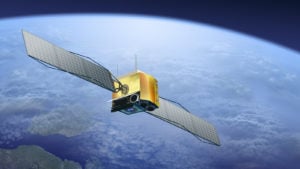
Some of the best picks in the space sector could launch to higher highs over the long term. Especially if analysts are right about the potential.
UBS analysts, for example, say it could rocket to $800 billion by 2030. By 2040, Morgan Stanley says it could be worth $1 trillion. All of this is great news for long-term investors. Or, if it’s a quicker win you’re after, simply trade the news. In fact, here are three of the best picks in the space sector to do that with.
Virgin Galactic (SPCE)

Long-term, Virgin Galactic (NYSE:SPCE) is a solid bet on a potential trillion-dollar space tourism industry. The company has a backlog of customers that already paid about $450,000 per ticket to traverse space for a few minutes. Also, further flight success could help ramp up both revenue and stock valuation, as noted on July 12.
Short-term, if you want to make money from Virgin Galactic, pay attention to news flow. For example, on Jan. 12, the company announced it was preparing for commercial space-line operations. Shortly after, the SPCE stock exploded from about $4.25 to a high of about $6.61. On May 8, SPCE announced it would return to space later in the month. The stock popped from about $3.70 to $5.25 on anticipation. On June 15, the stock popped again on news the company would start commercial space flights.
Rocket Lab (RKLB)

Or, take a look at Rocket Lab (NASDAQ:RKLB). The last time I mentioned RKLB, it traded at $6 on July 12. It would hit a high of $8.05 shortly after. One of the buy triggers emerged on June 23 when the company announced it would launch seven satellites into space, which sent the RKLB stock from $5.55 to $8.05 a share. On May 15, the company announced a date for its second NASA Tropics launch, which was another major trigger event at $4.07 a share.
Or, take a look at what happened around Jan. 11. The company announced a launch window for its first Electron mission from U.S. soil, and the stock popped from $4.35 to a high of $5.68. While some still argue we can’t trade the news based on efficient market theory, take a look at the time between the release of news and how long it took the stock to price it in.
ARK Space Exploration & Innovation ETF (ARKX)

Or, if you just want to set it and forget it, buy the dips on the ARK Space Exploration & Innovation ETF (BATS:ARKX). The last time I mentioned ARKX, it traded at around $13.81 on Feb. 13.
Today, it’s up to $15.25 and could see higher highs. The ETF typically runs higher when its holdings have major news, too.
With an expense ratio of 0.75%, the fund, “aims for thematic exposure to Space Exploration, including orbital and suborbital aerospace, enabling technologies, and beneficiaries of aerospace activities, such as agriculture, Internet access, a global positioning system, construction, and imaging”.
Aside from the news, be aware of this technical trick to spotting bottoms in the ARKX ETF.
If you pull up a two-year chart of ARKX, add in relative strength (RSI), MACD, and Williams’ %R. Notice what happens to the ETF, when those three indicators get over-extended in oversold territory. For example, when RSI dips to or below its 30-line, it’s considered oversold. When MACD dips too low from the mean, it serves as confirmation oversold RSI. Now, add in Williams’ %R at or near its 80-line, and many times, the ETF will turn and pivot higher.
On the date of publication, Ian Cooper did not hold (either directly or indirectly) any positions in the securities mentioned. The opinions expressed in this article are those of the writer, subject to the InvestorPlace.com Publishing Guidelines.





